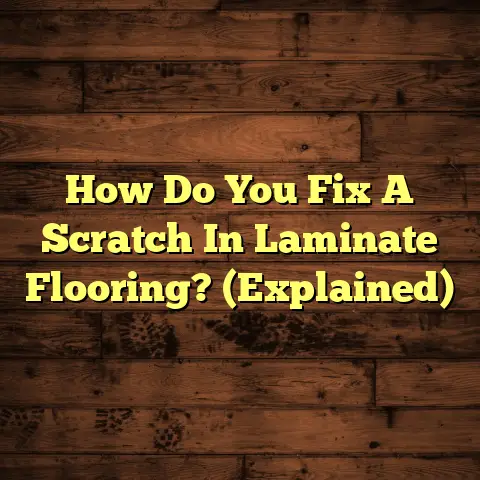Non-Slip Stick-On Tiles: Safe Homes? (2 to Avoid!)
(Opening Warning)
Let’s talk about something serious today: your safety at home.You know, those non-slip stick-on tiles promising to save you from nasty falls?
Well, I’m here to tell you that while they can be a lifesaver, they can also be a sneaky hazard if you don’t choose wisely.
I’ve seen firsthand how a well-intentioned quick fix can turn into a slippery situation – literally!
Trust me; you don’t want to learn this the hard way. Let’s dive deep and make sure you’re making informed decisions about your flooring.
1. Introduction
Non-slip stick-on tiles are popping up everywhere, right? They’re marketed as the easy solution to slippery floors, especially in areas like bathrooms and kitchens.
And with slip-and-fall accidents being a major cause of injury in homes, it’s no wonder people are reaching for them.
According to the National Safety Council (NSC), falls are a leading cause of unintentional injuries in the United States. In 2020 alone, falls resulted in 42,114 deaths. Source: Injury Facts, National Safety Council.
That’s a sobering statistic, and it highlights why we’re all looking for ways to make our homes safer.
But here’s the thing: not all non-slip tiles are created equal. Some can actually increase your risk of falling.
My goal today is to walk you through the ins and outs of non-slip stick-on tiles, point out the potential dangers, and highlight two specific types you should think twice about before buying.
Let’s make sure your quest for a safer home doesn’t backfire!
2. Understanding Non-Slip Stick-On Tiles
So, what exactly are we talking about when we say “non-slip stick-on tiles?”
These are typically thin, flexible tiles with an adhesive backing designed to be easily applied to existing flooring.
They come in a variety of materials, including:
- PVC (Polyvinyl Chloride)
- Rubber
- Vinyl
- Sometimes even cork
The designs range from plain, textured surfaces to decorative patterns that mimic ceramic or stone.
The big selling point is convenience. Homeowners love that they can quickly and affordably improve the safety of a slippery floor without the hassle of a full-blown renovation.
Think about it: no messy mortar, no special tools, and no waiting for days for the floor to cure.
Plus, many of these tiles look pretty good! They can freshen up a tired bathroom or add a touch of style to a drab kitchen floor.
But remember, looks can be deceiving.
3. The Science of Slip Resistance
Alright, let’s get a little technical for a moment. Understanding the science behind slip resistance is crucial for making smart flooring choices.
The key concept here is the coefficient of friction (COF). This measures how much resistance there is between two surfaces when one tries to slide across the other.
A higher COF means more friction, and therefore, less chance of slipping.
Flooring materials are tested to determine their COF, and these tests are performed under both dry and wet conditions.
The American National Standards Institute (ANSI) sets the standards for these tests. For example, ANSI A137.1 specifies the test methods and minimum COF values for various types of flooring.
Now, here’s a critical distinction: slip-resistant is not the same as non-slip. No flooring is truly 100% non-slip. Even the most textured surfaces can become slippery under the right conditions, like when they’re covered in oil or soap.
Slip-resistant flooring simply provides a higher level of friction than standard flooring, reducing the likelihood of slips and falls.
It’s essential to check the COF rating of any non-slip tile you’re considering. A tile with a low COF, especially when wet, may not provide adequate safety.
4. Common Types of Non-Slip Stick-On Tiles
The market is flooded with different types of non-slip stick-on tiles, each with its own set of features and claims.
Let’s take a look at some common varieties and then zero in on the two types I particularly want you to be cautious about.
You’ll typically find:
- Textured PVC Tiles: These have raised patterns or ridges to increase friction.
- Rubber Tiles: Rubber naturally has a high COF, making these a good choice for slip resistance.
- Cork Tiles: Cork is another naturally slip-resistant material that also offers cushioning.
- Grit-Embedded Tiles: These have small particles of abrasive material embedded in the surface to provide extra grip.
Now, let’s talk about the two types that can be problematic:
Type 1: Smooth Surface Non-Slip Tiles
These tiles often look very appealing. They might have a glossy finish or mimic the look of high-end stone or ceramic.
The problem? They often rely on a thin coating or treatment to provide slip resistance, and this coating can wear off quickly, especially in high-traffic areas.
More importantly, when these tiles get wet, they can become incredibly slippery.
Think about a bathroom floor. You step out of the shower with wet feet, and suddenly, you’re ice skating!
I’ve seen this happen time and time again. Homeowners install these tiles, thinking they’ve solved the problem, only to find themselves dealing with a dangerous situation.
Example: I once worked with a client who installed smooth surface non-slip tiles in their kitchen. They looked great, but after a few months, they noticed that the tiles became dangerously slippery whenever they spilled water or cooking oil.
One day, the client’s child slipped and fell, resulting in a minor injury. That’s when they called me to replace the tiles with a safer option.
The lesson here? Don’t be fooled by appearances. Always check the COF rating, especially the wet COF, before buying any non-slip tile.
Type 2: Low-Quality Adhesive Non-Slip Tiles
The effectiveness of stick-on tiles depends heavily on the quality of the adhesive.
If the adhesive is weak or poorly formulated, the tiles can start to peel or lift over time.
This creates a significant trip hazard. Imagine walking across your bathroom floor and suddenly catching your toe on a loose tile.
It’s a recipe for disaster.
What’s worse, low-quality adhesive can also degrade over time due to moisture or temperature changes. This can cause the tiles to become loose even if they were initially well-adhered.
Case Study: A few years ago, I inspected a home where the owners had installed low-quality adhesive non-slip tiles in their hallway.
The tiles looked fine at first glance, but upon closer inspection, I noticed that many of them were lifting at the edges.
The owners admitted that they had chosen the tiles based on price, without considering the quality of the adhesive.
Unfortunately, one of their elderly parents tripped on a loose tile and suffered a serious fall, resulting in a broken hip.
This incident highlights the importance of investing in high-quality non-slip tiles with a reliable adhesive.
Don’t skimp on quality when it comes to safety.
5. Risks and Consequences of Using Unsafe Non-Slip Stick-On Tiles
So, what’s the worst that can happen if you choose the wrong non-slip tiles?
The consequences can range from minor inconveniences to serious injuries and financial burdens.
- Injuries: Slips and falls can lead to bruises, sprains, fractures, and even head trauma. In severe cases, falls can be fatal, especially for elderly individuals.
- Medical Costs: Treating fall-related injuries can be expensive, involving doctor visits, emergency room care, physical therapy, and even surgery.
- Legal Liabilities: If someone is injured on your property due to unsafe flooring, you could be held liable for their medical expenses and other damages.
- Home Repair Costs: Replacing unsafe non-slip tiles can be costly, especially if you need to hire a professional contractor.
I’ve heard countless stories from homeowners who regretted choosing low-quality or inappropriate non-slip tiles.
Testimonial: “We installed those smooth, ‘non-slip’ tiles in our bathroom, and it was a disaster! My husband slipped and fell within a week. We ended up ripping them out and replacing them with something safer. It was a costly mistake.” – Sarah J., homeowner.
These stories are a stark reminder that safety should always be your top priority when choosing flooring.
Don’t let the allure of a quick fix or a low price cloud your judgment.
6. Conclusion
We’ve covered a lot of ground today, from the basics of non-slip stick-on tiles to the science of slip resistance and the potential risks of choosing the wrong products.
Remember, while non-slip stick-on tiles can be a convenient and affordable way to improve the safety of your home, they are not a foolproof solution.
It’s crucial to carefully research your options, check the COF ratings, and choose tiles with a high-quality adhesive.
And most importantly, be wary of smooth surface tiles and low-quality adhesive tiles. They may look good, but they can pose a serious safety risk.
Before you make any decisions, I urge you to consult with a flooring professional.
We can assess your specific needs and recommend the best flooring options for your home.
Your safety is worth the investment!





